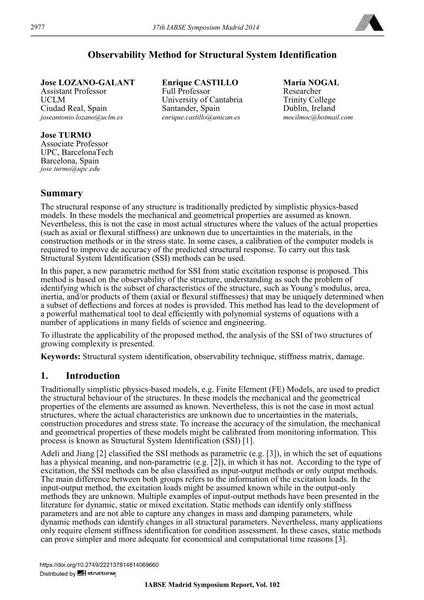Observability Method for Structural System Identification

|
|
|||||||||||
Bibliografische Angaben
| Autor(en): |
Jose Lozano-Galant
Enrique Castillo Maria Nogal José Turmo |
||||
|---|---|---|---|---|---|
| Medium: | Tagungsbeitrag | ||||
| Sprache(n): | Englisch | ||||
| Tagung: | IABSE Symposium: Engineering for Progress, Nature and People, Madrid, Spain, 3-5 September 2014 | ||||
| Veröffentlicht in: | IABSE Symposium Madrid 2014 | ||||
|
|||||
| Seite(n): | 2977-2984 | ||||
| Anzahl der Seiten (im PDF): | 8 | ||||
| Jahr: | 2014 | ||||
| DOI: | 10.2749/222137814814069660 | ||||
| Abstrakt: |
The structural response of any structure is traditionally predicted by simplistic physics-based models. In these models the mechanical and geometrical properties are assumed as known. Nevertheless, this is not the case in most actual structures where the values of the actual properties (such as axial or flexural stiffness) are unknown due to uncertainties in the materials, in the construction methods or in the stress state. In some cases, a calibration of the computer models is required to improve de accuracy of the predicted structural response. To carry out this task Structural System Identification (SSI) methods can be used. In this paper, a new parametric method for SSI from static excitation response is proposed. This method is based on the observability of the structure, understanding as such the problem of identifying which is the subset of characteristics of the structure, such as Young’s modulus, area, inertia, and/or products of them (axial or flexural stiffnesses) that may be uniquely determined when a subset of deflections and forces at nodes is provided. This method has lead to the development of a powerful mathematical tool to deal efficiently with polynomial systems of equations with a number of applications in many fields of science and engineering. To illustrate the applicability of the proposed method, the analysis of the SSI of two structures of growing complexity is presented. |
||||
| Stichwörter: |
Schaden Steifigkeitsmatrix
|
||||
